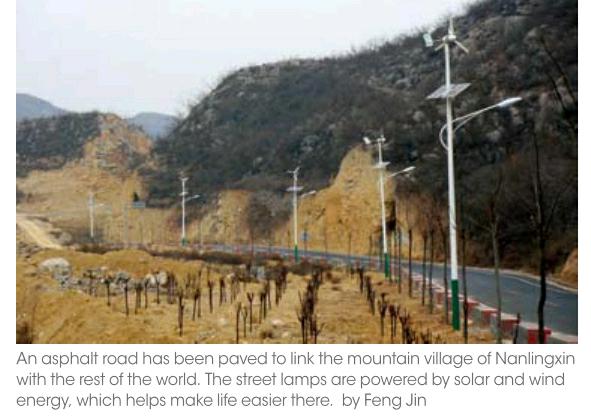In Roads
by+Wang+Hao+and+Qin+Yanfeng
Located in central Henan Province, Nanlingxin Village is part of Xiaoguan Town in Gongyi City. With 2,700 residents spread across 806 households, Nanlingxin is considered one of the most impoverished villages in the area – which is deep in the mountains with little arable land and a lack of natural resources.
At the end of 2013, the Chinese government enacted the policy of “precision poverty alleviation.” To implement the policy, leaders of Nanlingxin Village established archives for poverty-stricken households and assigned special personnel to oversee research. Their diagnosis was that many of the problems could be traced back to roads.
It takes about a half hour to drive from the parent city to the village on a straight, bumpy road. “It was paved in 2014,” reveals Li Guozhen, secretary of the villages committee of the Communist Party of China (CPC), who manages poverty alleviation campaigns. “After it opened to traffic, the road offered easy access for villagers, who hoped to develop local tourism.”
As we approached the village, houses scattered along the hillside started appearing one by one, some newly built with bricks and tiles amidst old stone huts. “In 2002, the year I took office as Party secretary, the village didnt have a proper road at all,” adds Li. “Most people lived in stone huts. When it rained, we were stuck on the mountain because there was no way out. The average income was less than 600 yuan a year.”
To change the situation, the village committee brainstormed and experimented before making road construction the top priority. They hunted for funds and eventually secured government support as well as donations from committee members. The whole village was mobilized to build the road.
“Everyone was enthusiastic upon hearing the news,” continued Party Secretary Li. “Nobody complained and refused when they were asked to relocate. They packed up without hesitation.”
Thanks to the joint efforts of the villagers, in four years, four roads were built with a total length of over 10 kilometers.
Connection with the outside world has brought dramatic change to the small mountain village. “It was hard to sell our local products downtown before we had the road,” remarks Wang Ping, who runs a sheep farm. “It usually took a whole day to travel back and forth.”
Although a native, Wang has spent much of her life away from the village. Even after graduating from a high school in the 1980s, she still didnt return to the village. When the roads opened in April 2014, however, she decided to return and start a business.
“It was unbearable to see walnuts, apricots, and persimmons rot on the ground because of inconvenient transportation,” she laments.“Things are different today thanks to the roads: My fellow villagers are shaking off poverty.” Today, lush walnut trees can be found almost everywhere along 200 hectares of the hillside, along with dozens of hectares of persimmons. People no longer struggle to sell their harvests. “There is always someone at the doorstep as soon as fruits get ripe,” she grins. “Some villagers can make as much as 20,000 yuan or more from walnuts a year. Moreover, byproducts from the plants are sold as far away as outside Henan Province.” The unimpressive roads have led locals on a climb to prosperity.
Roads have brought business opportunities, gifting Nanlingxin better prospects for development. The village committee has invested great efforts in upgrading the capabilities of the villagers by offering various training classes, such as cooking and cultivation.
“In days past, many villagers dreamed of getting out,” explains Party Secretary Li. “Today, nobody wants to go anywhere else. Theyre too busy thinking about how to make money: planting fruit or operating farmers restaurants.”
By the end of 2015, there were only 44 impoverished households including 11 disabled villagers. Starting this year, the disabled will enjoy subsidies, and other impoverished households will receive differentiated assistance. Planners hope to see the final glimpses of poverty disappear by the end of 2016.

